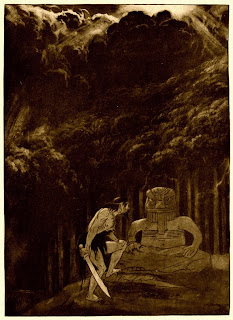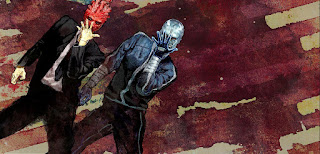I figure it’s about time to hammer this old nonsense into something I can actually playtest. For this iteration, I wanted to make the religion-building aspects a little more baked in. Anyway, if you play in any of my games, you are free to choose this class (unless somebody else is already playing it. Running two of these at once is probably pretty dicey).
Shrine, a class for old school D&D-alikes
 |
| by sydney sime |
You are an intangible, invisible spiritual presence, unable to interact with the physical world except through your shrine and those who worship it. You can speak with anyone in earshot of your shrine, and you can see anything in line of sight. If your shrine is destroyed, you lose your only connection with the real world until someone decides to build a new one for you.
The Cult
Worshipers are a mercenary lot, so inducting someone into your cult requires you to hire pay them like any other retainer (LotFP has good procedures for this). Once you’ve indoctrinated/bribed someone into your religion, you perceive everything they sense. You can also speak directly to your retainers, as well as anyone in line of site of them.
If you wish, you can possess one of your retainers. When you do so, you control them directly and use your abilities and attributes in place of theirs, including HP (so rolling Strength during character creation wasn’t a waste). However, if you are reduced to 0 HP while possessing a character, you both die. Extricating yourself from a retainer’s body takes a number of turns equal to your level and causes them to make a Loyalty/Morale check as soon as you’ve left them.
 |
| by harry clarke |
Starting at level 3, you can acquire a Saint, who functions as a henchman in LotFP (they are a classed character two levels behind you, and get half of your treasure). Saints never check Morale, and all followers in their presence get a +1 to Morale.
Miracles
In a typical D&D system, you cast spells just like a cleric. If your DM is cool and has Wonders and Wickedness, you cast spells as a specialist sorcerer. Your school of magic and flavor of Maleficence determines your portfolio as a minor divinity. You don’t need to prepare spells–you can expend a spell slot to cast any spell you know.
Casting a spell does not require any of your retainers to take an action–it’s your divine intervention, after all. However, you must use one of your retainers as the origin point for any spell you cast so if a spell has a range of 100 ft, your target must be in 100 ft of your shrine or one of your followers). Furthermore, your might probably have some funny ideas about what participation in a cult entitles them to and get mad when you ignore their invocations (when a retainer calls on your power and you don’t provide a miracle, they make a Morale check).
You can’t learn new spells through research or transcription. Instead, whenever your followers burn a scroll or spellbook in your name, you learn all spells inscribed therein. If your followers sacrifice a wizard to you, you can choose to learn a single spell he or she had memorized.
Apostasy
If a hireling fails a Morale check, you can’t perceive with their senses, possess them, or use them as the origin for spell/miracles. However, if you manage to reconvert/rehire them, they get a permanent and cumulative +1 bonus to Morale/Loyalty.
Grow in Power
You don’t get experience just by collecting money. Instead, you get 1 xp for every gold piece spent improving your shrine. You also gain xp for building additional shrines. Establishing a shrine costs 2,000 gp. You can acquire worshipers in any town you have a shrine.
In addition to your HP, saving throw, and spell progression, you must issue an edict each time you gain an even level. An edict is a behavioral restriction that all of your followers must carry out. This might make adventuring life more difficult for them, but each gives all followers a permanent +1 bonus to Morale.
Other Stuff
LotFP has a bunch of kinds of retainers, but weirdly doesn’t include easy options for hiring mercenaries singly or day by day. I’ll say godlings (and only godlings) can hire cultists (who function as 0th level fighters, elves, halfings, or dwarves, to be randomly determined) for 10 sp a day + 10% cut of the treasure. Otherwise it’s linkboy’s and butlers.
An angry employer/divinity can compel a retainer or follower to reroll a Morale/Loyalty check through intimidation, threats, or show of force, but this causes a permanent -1 to Morale/Loyalty.
























